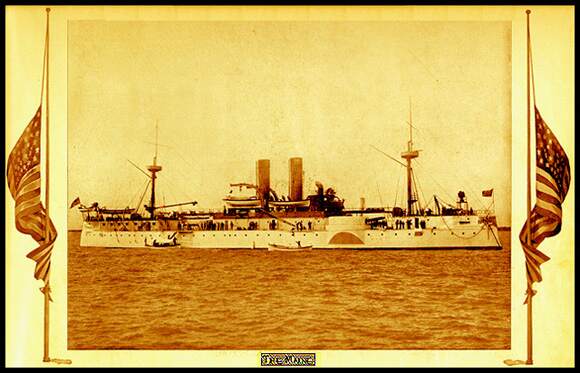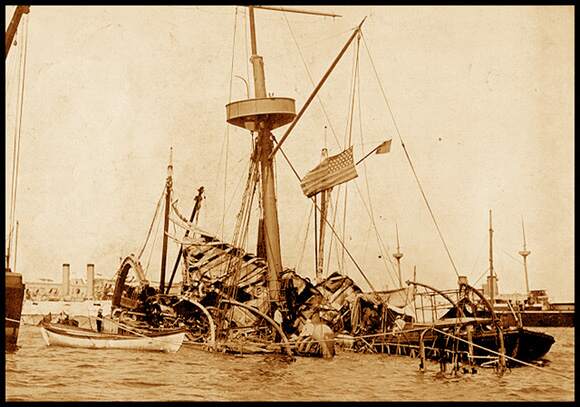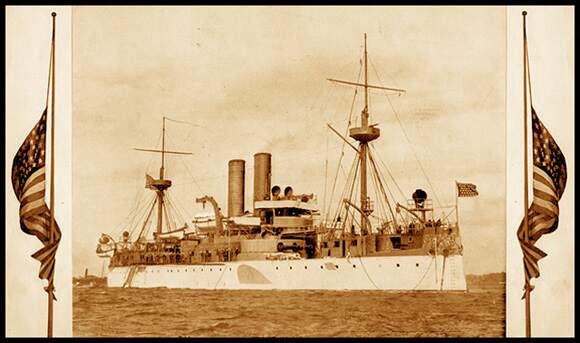


Analysis of Theories on the Loss of the MAINE
Report of the US Court of Inquiry ||| McKinley Reports on the loss to Congress
The Funeral ||| How Likely was a Coal Bunker Fire? ||| Salvage and Final Voyage
The USS MAINE was unique at the time in that she was purely the product of American naval design, and was built at a U.S. Naval Yard. By contrast, her contemporary, the USS TEXAS, was the product of a design competition, based on an English design, and constructed by a naval contractor. In fact, the USS MAINE is the largest vessel to be actually built in a U.S. Navy Yard.
The new battleship MAINE was a showpiece for the United States Navy and was given many ceremonial tasks. For instance, it took part in the 1897 Mardi Gras ceremony in New Orleans, Louisiana along with the USS TEXAS. Between June and December 1897, the vessel could be found cruising off the coast of the United States between Virginia and Connecticut. On December 15, 1897, she got underway, heading south toward Florida and her final destiny.
The USS MAINE arrived in Cuba's Havana harbor on January 24, 1898. Because of propaganda from the U.S. newspapers and the Cuban Insurgents, the situation in Cuba was not fully understood in Washington DC. The U.S. Consul in Havana, Fitzhugh Lee, was also somewhat out of touch with the country in which he was living. In response to a small protest by Spanish officers, not affecting the United States, Washington sent the USS MAINE, under the command of Capt. Charles Sigsbee, to Cuba on a "friendly" visit. At about 9:30 PM on February 15, the MAINE was shattered by two separate explosions and rapidly sank. Two hundred and fifty-two men were killed. Ammunition continued to explode for hours after the blast.
 After the disaster, U.S. newspapers were quick
to place responsibility for the loss on Spain. In spite of the newspaper
propaganda, an official court of inquiry was held by the U.S. Navy to
determine the cause of the blasts. The Navy concluded that the ship was
sunk by a mine which ignited the forward magazines, but stated that it
could not fix responsibility upon any person or persons, including the
government or military forces of Spain. Regardless of the reality of the
situation, the loss of the USS MAINE had turned American popular opinion
strongly in favor of war with Spain. Despite of his efforts to avoid
war, President McKinley finally decided to
militarily intervene in Cuba to end the ongoing unrest and "liberate"
Cuba from Spanish rule. Later studies have indicated the possibility
that the USS MAINE sunk as a result of a coal
bunker fire adjacent to one of its ammunition magazines, and not a
result of a Spanish mine.
After the disaster, U.S. newspapers were quick
to place responsibility for the loss on Spain. In spite of the newspaper
propaganda, an official court of inquiry was held by the U.S. Navy to
determine the cause of the blasts. The Navy concluded that the ship was
sunk by a mine which ignited the forward magazines, but stated that it
could not fix responsibility upon any person or persons, including the
government or military forces of Spain. Regardless of the reality of the
situation, the loss of the USS MAINE had turned American popular opinion
strongly in favor of war with Spain. Despite of his efforts to avoid
war, President McKinley finally decided to
militarily intervene in Cuba to end the ongoing unrest and "liberate"
Cuba from Spanish rule. Later studies have indicated the possibility
that the USS MAINE sunk as a result of a coal
bunker fire adjacent to one of its ammunition magazines, and not a
result of a Spanish mine.
The USS MAINE rested on the floor of Havana Harbor until 1911. In that year, a cofferdam was built around the wreck. The hull was patched enough to enable it to float. Based on what was found, a second inconclusive court of inquiry was held, one of many to come. The wreck was then towed out of the harbor and sunk in sea. It now lies at a depth of thirty-six hundred feet.
Many momentos of the USS MAINE still exist. The mainmast is in Arlington National Cemetery, just outside of Washington DC, and her foremast is near the seawall at the Naval Academy in Annapolis, Maryland. One of her bow anchors is located in Reading, Pennsylvania's City Park at the first block of North 11th Street. Her capstan rests in the Battery in Charleston, South Carolina, and her bow scroll is in Bangor, Maine. Many pieces of the USS MAINE were made into small collectibles such as ashtrays, plaques, models, etc.
One major problem with this type of vessel, and a common problem aboard warships of the time period, was that the coal bunkers were used as additional "armor" to protect the magazines. The bunkers were placed around the perimeter of the ship, and magazines were placed inboard of this extra layer of protection. Spontaneous combustion fires in coal bunkers were a possibility, though, unlike some naval vessel, MAINE had no history of coal bunker fires. A burning coal bunker on the opposite side of a bulkhead from a magazine full of ammunition presented a real and great danger.
Interestingly, when the USS MAINE was finally launched and loaded with supplies, it was found that the bow had a draft three feet greater than the stern. This imbalance was the result of a mistake in the loading plan. Forty-eight tons of ballast had to be installed near the stern to put the ship back on an even keel. The USS MAINE therefore had a greater draft than planned as well as valueless additional weight.
MAINE was caught between two separate roles in the navy and could not actually fulfill either. She did not have the armor nor the firepower to slug it out as a ship-of-the-line as was the intended role of a battleship. She did not have the speed required to serve as cruiser. Cruisers were intended to be commerce raides, and therefore had to have guns large enough to attack anything smaller (which MAINE had) but she did not have the speed to be able to get away from something larger, as was expected of a cruiser. As a result, her intended role in the navy was ill-defined.
Her coal capacity was quite low at 895 tons (significantly lower capacity than either that of a cruiser such as OLYMPIA or a battleship like OREGON) As a result the length of time she could spend at sea was limited, and her ability to run at flank speed, where coal consumption increased dramatically, was limited. MAINE's overhanging turrets did not permit her to be coaled at sea from a collier without risk of damage to both her and the collier except in the smoothest of seas. This compounded her range/coal capacity problem
The greatest problem MAINE faced was her odd turret configuration. The
guns were not counterbalanced. If both sets were turned one direction,
the ship heeled over that direction, reducing the range. Firing the
turret on one side of the ship toward the opposite side of the ship was
possible, and intended. This required firing across the deck and through
the superstructure. The vacuum created by the passing shell would damage
deck and superstructure alike. Also if there was a mistake and the gun
was fired prematurely, MAINE could actually shoot itself!

| Classification: | Second Class Battleship (formerly Armored Cruiser, ACR-1) | |
|---|---|---|
| Keel Laid: | October 11, 1888 | |
| Commissioned: | September 17, 1895 | |
| Rig: | Two military masts, planned sails never provided. | |
| Armament: | Four 10" guns in two turrets | |
| Six 6" guns | ||
| Seven 6-pounders | ||
| Eight 1-pounders | ||
| Several Colt Machine Guns (for landing parties) | ||
| Four 14" surface torpedo tubes | ||
| Contractor: | Designed by the U.S. Navy Bureau of Construction, and built | |
| at the New York Navy Yard in Brooklyn, New York. | ||
| Length: | 319 feet | |
| Beam: | 57 feet | |
| Mean draft: | 22 feet | |
| Displacement: | 6,682 tons | |
| Complement: | Under the command of Captain Charles Sigsbee | |
| Engine type: | Twin screw vertical inverted triple expansion engines, | |
| manufactured by Quintard Iron Works, and generating 9,000 hp. | ||
| The two propellers were 15 feet in diameter. | ||
| Speed: | 15 knots | |
| Coal bunker capacity: | 896 tons |
Blow, Michael, A Ship to Remember , (New York: William Morrow and Company, Inc., 1992).
Clerk of Joint Comittee on Printing, "The Abridgement of Message from the President of the United States to the Two Houses of Congress", Washington: Government Printing Office, 1899. 4 vols. (all are documents relating to the war).
Harris, Lt. Cmdr. Brayton, "The Age of the Battleship", New York: Franklin Watts, Inc., 1965.
Jeffers, H. Paul, Colonel Roosevelt: Theodore Roosevelt Goes to War, 1897-1898. (New York: John Wiley & Sons, Inc., 1996).
Millis, Walter, The Martial Spirit. (Cambridge: The Riverside Press, 1931).
Naval History Department, Navy Department, "Dictionary of American Naval Fighting Ships", Washington DC: Government Printing Office, 1959.
Peña, Félix Alfonso (location of the MAINE's bow anchor)
Samuels, Peggy and Harold, Remembering the Maine. (Washington: The Smithsonian Institution Press, 1995.